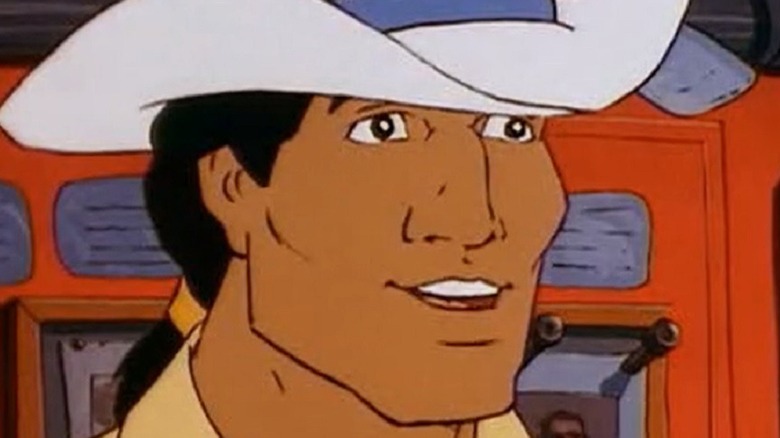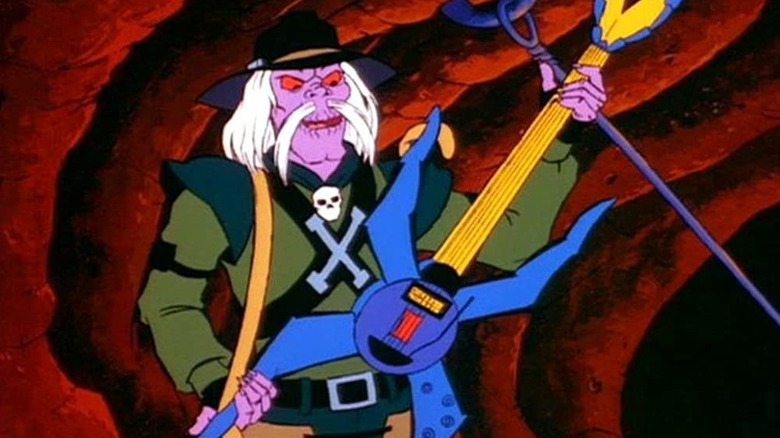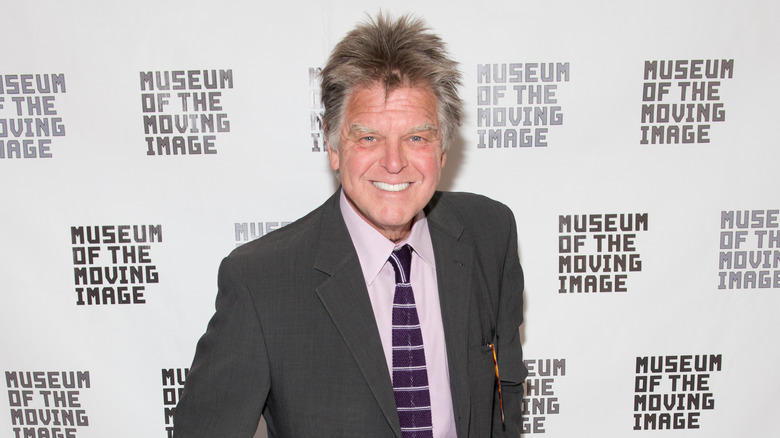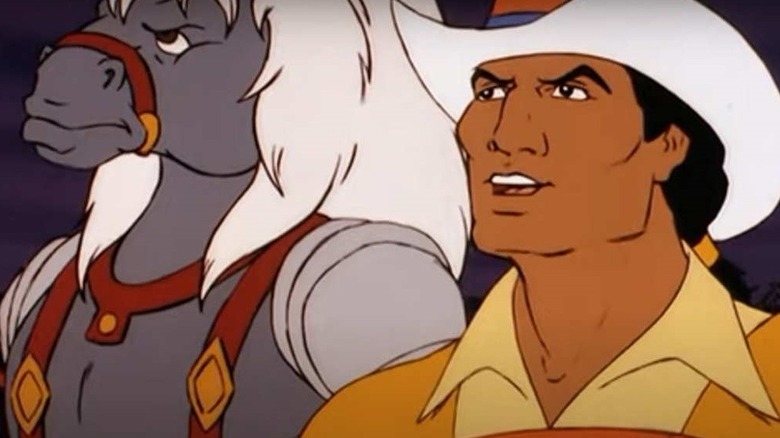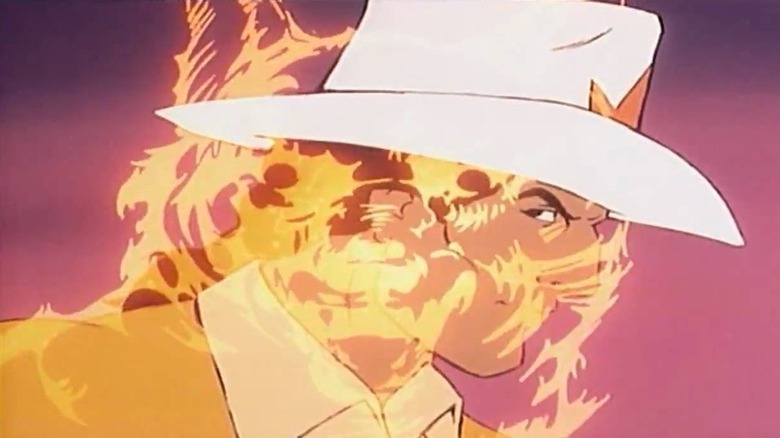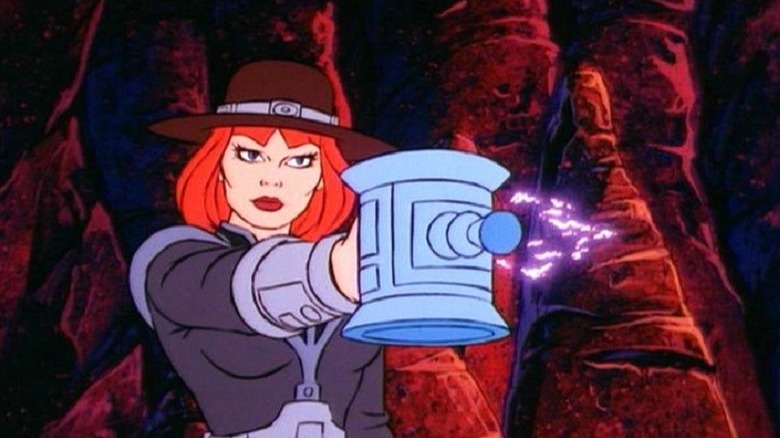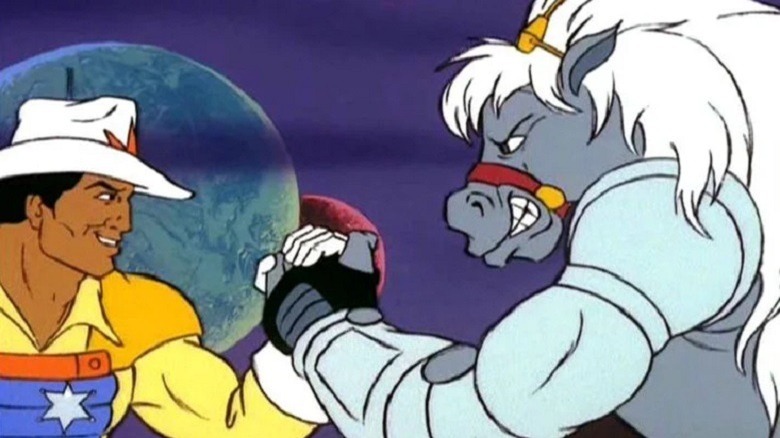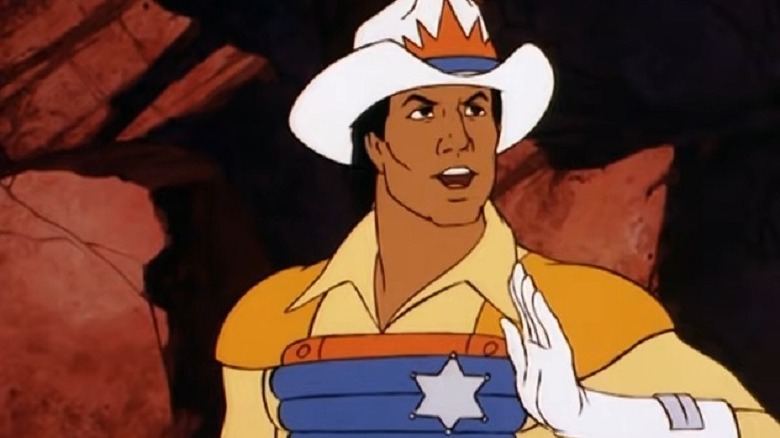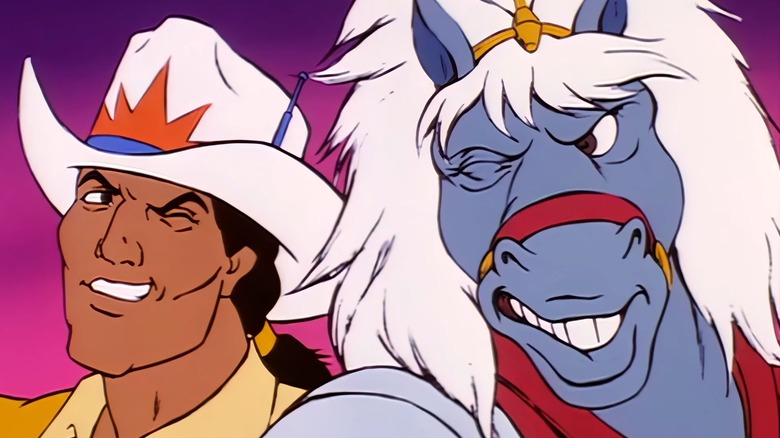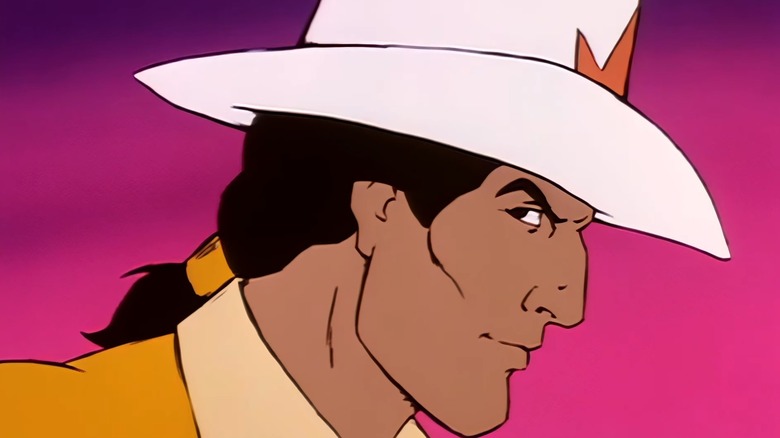The Untold Truth Of BraveStarr
Name one cartoon character who has the eyes of the hawk, ears of the wolf, strength of the bear, and speed of the puma. Of course, there's only one: Marshal BraveStarr, the protector and law enforcer of New Texas. From 1987 to 1988, he kept the prairie safe from the likes of Tex Hex and the rest of the Carrion Bunch. He wasn't alone in his quest for justice, though, as he was flanked by his trusty steed Thirty/Thirty, Deputy Fuzz, and Judge J.B. McBride.
Despite the enticing space western premise, "BraveStarr" wasn't exactly the big hit that its production studio Filmation and toy manufacturer Mattel expected in the late 1980s. Both companies invested sizable sums in the franchise, and they suffered major consequences when it ended up shooting blanks. While it might not have been the success that everyone hoped for, it has built up a cult following among animation fans who appreciate its originality and its desire to do something different at the time. So let's ride on into New Texas and dig up all the dirt on the untold truth of "BraveStarr."
Tex Hex came first
Every hero needs a good villain — the dark to their light. Sometimes, the herald of justice is directly responsible for creating their greatest adversary, such as Batman holding a role in the birth of the Joker or Obi-Wan Kenobi training Anakin Skywalker. However, in the case of Marshal BraveStarr, his biggest baddie was created before he was even a twinkle in the animation team's eye.
Per The Los Angeles Times, Tex Hex was originally planned as a character for Filmation's "Ghostbusters" series. His creepy appearance and blood-red eyes certainly wouldn't have looked out of place on the spooky show, but Filmation's co-founder, Lou Scheimer, saw potential in the character's design and chose to reserve him for something else. Deciding to pursue the idea further, he challenged his team to play around with Tex Hex and see what they could come up with. The tinkering began and the concept of a futuristic western series came to fruition, with BraveStarr arriving later on in the development phase. On a side note, has anyone else noticed how Tex Hex looks like a mixture of Lemmy Kilmister from Motörhead and Hulk Hogan?
BraveStarr's voice actor loved the idea for the show
As a voice actor, Pat Fraley has done it all. He voiced Krang, Baxter Stockman, Casey Jones, and countless other characters in the 1987 "Teenage Mutant Ninja Turtles" cartoon and lent his talents to other popular animated shows such as "The Addams Family," "DuckTales" and "Goof Troop." One of his landmark performances, however (albeit one that would have been more appropriate for an Indigenous voice actor), was as the titular hero in "BraveStarr," and Fraley has nothing but praise for the series and what it tried to achieve over its 65 episodes.
"I thought it was the most creative endeavor that the producing company, Filmation, ever attempted," he told Rutger's TMNT Autograph Collection. "It was a science fiction western. It should have done better." Fraley isn't the only person who holds that opinion about "BraveStarr," as most of the folks involved in the project were baffled by its quick failure. Unfortunately, the franchise's fate was largely determined by forces outside of the creative team's control.
Mattel didn't want the action figure to have a ponytail
In the 1980s, action figures weren't made to complement animated series; it was the reverse. Many shows served mainly as half-hour advertisements to get children to convince their parents to purchase the latest figures and playsets. Mattel was a major player of the era, as its "Masters of the Universe" franchise broke sales records and ensured that the toy craze turned into a lucrative gravy train.
When Filmation approached the toy giant with the idea for "BraveStarr," Mattel didn't hesitate for a second (per The Los Angeles Times). It saw the potential right away — with a few caveats, of course. For one, Mattel suggested that the hero be kitted out in blue rather than gold, citing market research of what colors boys preferred. However, a compromise was ultimately reached on that front. Then, there was the issue of BraveStarr's ponytail. Mattel insisted that boys wouldn't want an action figure with such a hairstyle, so it shortened the character's cut for the toy. Filmation still kept the ponytail for the show, though, only shortening it ever so slightly.
The book that inspired BraveStarr
In a 1994 interview with TOON Magazine, Lou Scheimer explained the process of creating "BraveStarr" and what drew him to the idea (via BraveStarr.org). He said that he felt Native Americans had been neglected and treated poorly overall by children's shows, and he wanted to help remedy that. While bouncing around ideas of who could be the protagonist to Tex Hex's antagonist, he recalled a book that he'd read that ultimately served as a direct inspiration for the show.
Scheimer cited Andre Norton's 1959 sci-fi novel "The Beast Master." The story follows Hosteen Storm, a Navajo man who possesses the ability to form telepathic bonds with animals in the future. The novel was eventually turned into the 1982 cult classic film "The Beastmaster," which starred Marc Singer and eventually became part of a trilogy. The Native American elements of the original story were removed in the film adaptation. Scheimer believed the book's premise was a good idea and found ways to emphasize more futuristic space elements when creating "BraveStarr."
Mattel insisted that the movie be changed
"BraveStarr: The Movie" was intended to be the start of the franchise, introducing the characters and the planet of New Texas. However, the film was ultimately delayed until after the series had already aired. Despite the hold-up in its release, it still maintained its origin story element, showcasing how BraveStarr and Tex Hex came to be mortal enemies and the importance of Kerium to the planet.
Yet, the version of "BraveStarr: The Movie" that Filmation ultimately released wasn't the one they originally wanted to make (per The Los Angeles Times). New Texas was the name settled on after Mattel decided against New Cheyenne, believing that kids wouldn't understand the significance of it. The toy company also requested that the storyline be simplified in the interest of merchandising, meaning that much of the intricate worldbuilding Filmation planned on executing would have to be left to the animated series. Ironically, none of this mattered much in the end since Mattel released the toyline before either the series or the movie ever premiered.
Mattel really bungled the release schedule
Which came first, the chicken or the egg? It's a question that's plagued humanity for the longest time. Mattel experienced a similar dilemma of its own with "BraveStarr," as the company decided to release the toys before the series had aired a singular episode. These were the days before YouTube and social media, so most of the hype for action figures came from the corresponding animated shows and movies themselves.
Mattel decided to release the toys in stores in early December, trying to capitalize on the holiday season buzz and parents buying gifts for their kids. The plan didn't work out as expected, however, and the sales tanked. It was a decision that perplexed everyone, including Filmation's Lou Scheimer. As he wrote in his autobiography, "Lou Scheimer: Creating the Filmation Generation," "Kids would look at those toys and not know how to play with them; they didn't know what the relationships were. I couldn't stop Mattel because I had made a deal with them to have the rights." In a separate interview with TOON Magazine, Scheimer claimed that Mattel was going through a tough time business-wise, so the speeding up of the toys' release timeline likely came from a place of desperation (via BraveStarr.org).
A writer quit Filmation out of disgust
For all the people working on "BraveStarr," it must have been heartbreaking to see the impact of the toyline arriving before the series debuted. Everyone in the animation world understood how dependant a show's success and possible renewal were on the toy sales, and Mattel's risky decision ultimately didn't pay off.
One member of the "BraveStarr" creative team wasn't left upset by the toyline release as much as he was by Filmation's insistence to delay "BraveStarr: The Movie." The film was meant to serve as an origin story, but it wasn't released until after the series had already debuted. "Their directors were old and uninterested in quality, and the animators were bogged down by the Filmation stock system," writer Bob Forward told Busta Toons (via BraveStarr.org). "The series bombed, the movie went almost direct to video, and I quit the company in disgust." Despite it being a challenging experience, Forward stated that he believed the film was decent and praised many of the scripts written for the show.
BraveStarr was Lou Scheimer's favorite series
Founded in 1962, Filmation was responsible for many happy childhood memories before it shut its doors in the late 1980s (per Den of Geek). The animation studio delivered many beloved shows such as "He-Man and the Masters of the Universe," "The New Adventures of Batman" and "Ghostbusters." However, even after all those huge hits, Lou Scheimer held a special place in his heart for "BraveStarr."
In a conversation with Critical Blast, Scheimer revealed that "BraveStarr" was his favorite series. "My favorite, and more fun because I was a science fiction nut and I like westerns," he said while reminiscing about the show. Scheimer added that it surprised him that "BraveStarr" didn't do as well as some of the other programs, since he anticipated it would be a hit. The expectations were so high that it could have changed the course of Filmation's future forever. Unfortunately, due to the lackluster reception at the time and poor sales of the action figures, "BraveStarr" ended up being the production company's last major project.
BraveStarr was expected to make $200 million
No one creates anything with the intention of it being a flop. Everyone dreams of success and hopes for the absolute best. In the case of Mattel and Filmation, their expectations were sky-high for "BraveStarr." The two companies believed they had something special and unique in their back pocket — an entertaining concept that would resonate with the children of the time.
According to The Los Angeles Times, over $15 million worth of "BraveStarr" toys had been shipped by November of 1986. It was a massive investment in the franchise, which was projected internally to earn a staggering $200 million by 1988. Unfortunately, that's the sad part about dreams — sometimes they just don't come true. "BraveStarr" might have had all the right ingredients to be one of the biggest franchises of its time, but the order of events simply didn't work out. It's a reminder of the age-old idiom: "You have to learn to walk before you can run."
